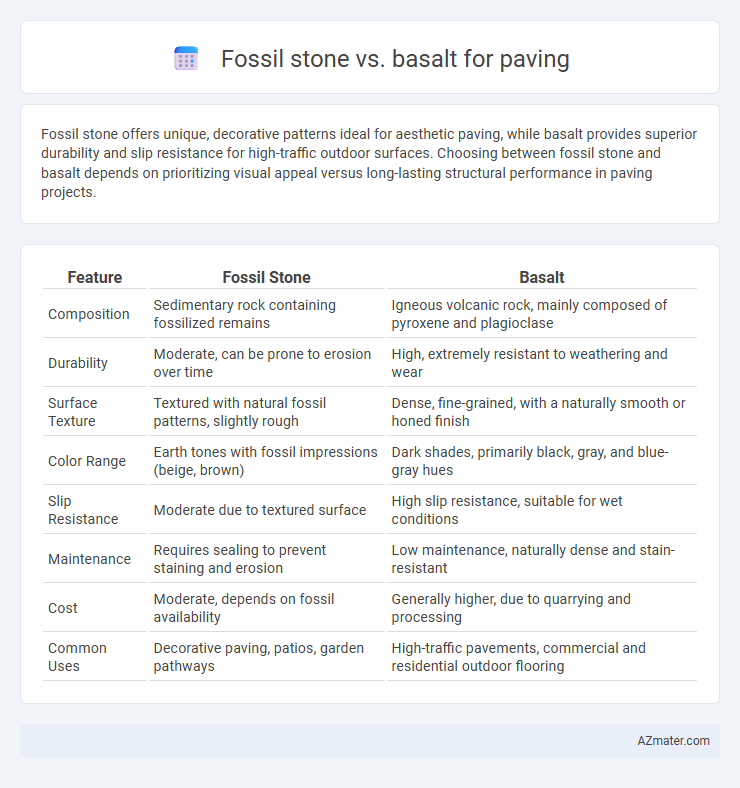Fossil stone offers unique, decorative patterns ideal for aesthetic paving, while basalt provides superior durability and slip resistance for high-traffic outdoor surfaces. Choosing between fossil stone and basalt depends on prioritizing visual appeal versus long-lasting structural performance in paving projects.
Table of Comparison
| Feature | Fossil Stone | Basalt |
|---|---|---|
| Composition | Sedimentary rock containing fossilized remains | Igneous volcanic rock, mainly composed of pyroxene and plagioclase |
| Durability | Moderate, can be prone to erosion over time | High, extremely resistant to weathering and wear |
| Surface Texture | Textured with natural fossil patterns, slightly rough | Dense, fine-grained, with a naturally smooth or honed finish |
| Color Range | Earth tones with fossil impressions (beige, brown) | Dark shades, primarily black, gray, and blue-gray hues |
| Slip Resistance | Moderate due to textured surface | High slip resistance, suitable for wet conditions |
| Maintenance | Requires sealing to prevent staining and erosion | Low maintenance, naturally dense and stain-resistant |
| Cost | Moderate, depends on fossil availability | Generally higher, due to quarrying and processing |
| Common Uses | Decorative paving, patios, garden pathways | High-traffic pavements, commercial and residential outdoor flooring |
Introduction to Fossil Stone and Basalt Paving
Fossil stone paving features unique patterns created by the preserved remains of ancient marine life, offering an aesthetically rich and natural texture that enhances outdoor spaces. Basalt paving is known for its durability and dense structure, providing a robust, weather-resistant surface ideal for high-traffic areas. Both materials bring distinctive qualities to paving projects, with fossil stone emphasizing decorative appeal and basalt focusing on strength and longevity.
Composition and Formation of Fossil Stone
Fossil stone, primarily composed of compacted marine fossils such as shells and corals embedded in calcium carbonate, forms through sedimentation and mineralization over millions of years, preserving intricate organic patterns. Basalt is an igneous rock formed from rapidly cooled lava, predominantly consisting of fine-grained minerals like pyroxene and plagioclase feldspar, resulting in a dense and durable texture. The organic composition and fossilized formations in fossil stone provide unique aesthetic appeal for paving, contrasting with basalt's uniform hardness and resistance to wear.
Geological Origins of Basalt
Basalt originates from rapid cooling of basaltic lava flows, forming a dense, fine-grained igneous rock primarily composed of plagioclase and pyroxene minerals, making it exceptionally durable for paving applications. Fossil stone, often sedimentary and rich in preserved organic material, contrasts sharply in formation, leading to a different texture and porosity that affects its longevity and weather resistance. The geological origin of basalt contributes to its superior strength and low water absorption, ideal for high-traffic outdoor surfaces.
Aesthetic Differences: Fossil Stone vs Basalt
Fossil stone paving showcases intricate, natural fossil patterns and earthy tones that create a unique, rustic aesthetic ideal for accentuating outdoor spaces with historical charm. Basalt paving features a sleek, uniform dark gray to black surface providing a modern, minimalist appearance that enhances contemporary landscaping designs. The contrasting textures and colors of fossil stone and basalt offer distinct visual impacts, influencing design choices based on desired ambiance and architectural style.
Durability and Weather Resistance Comparison
Fossil stone offers moderate durability with a unique textured surface but is more porous, making it susceptible to weathering and erosion over time. Basalt exhibits high durability and excellent weather resistance due to its dense, fine-grained structure, which withstands freeze-thaw cycles and heavy foot traffic without significant wear. For paving applications demanding long-term resilience, basalt is preferred for its superior strength and low maintenance in harsh climates.
Surface Texture and Slip Resistance
Fossil stone offers a naturally textured surface with intricate patterns that enhance slip resistance, making it suitable for decorative paving with moderate foot traffic. Basalt features a dense, fine-grained surface that can be honed or flamed to increase traction, providing superior slip resistance suitable for high-traffic and wet environments. The choice between fossil stone and basalt depends on desired aesthetic appeal and specific slip-resistance requirements for safety and durability.
Maintenance Requirements for Each Stone
Fossil stone requires regular sealing to prevent staining and maintain its polished appearance, with periodic cleaning using pH-neutral detergents to avoid surface damage. Basalt boasts superior durability and low porosity, necessitating minimal maintenance primarily consisting of routine sweeping and occasional washing to remove dirt and debris. While fossil stone may need more frequent upkeep due to its softer nature, basalt's resilience makes it ideal for high-traffic paving areas with reduced maintenance efforts.
Environmental Impact and Sustainability
Fossil stone, derived from sedimentary rock containing preserved ancient organisms, typically requires less energy-intensive quarrying compared to basalt, a dense volcanic rock known for its hardness and durability. Basalt offers superior longevity and resistance to wear, reducing the need for frequent replacement and thus lowering long-term environmental impact. Fossil stone's extraction often has a lower carbon footprint, but basalt's extended lifespan contributes to sustainable paving solutions by minimizing resource consumption and maintenance over time.
Cost Comparison: Fossil Stone versus Basalt
Fossil stone generally costs more than basalt due to its unique fossilized patterns and limited availability, making it a premium choice for paving projects seeking aesthetic appeal. Basalt offers a more budget-friendly option with its abundant supply and durability, often favored for large-scale paving requiring cost-efficiency. Installation and maintenance costs for both materials are comparable, but the initial investment for fossil stone remains higher due to specialized quarrying and processing.
Best Applications for Each Stone in Paving
Fossil stone, rich in visible ancient marine fossils, is ideal for decorative paving in patios and garden pathways where aesthetic appeal and natural texture are desired. Basalt, a dense and durable volcanic rock, excels in high-traffic areas such as driveways, sidewalks, and commercial plazas due to its superior strength and slip resistance. Each stone's unique properties cater to specific paving needs: fossil stone for ornamental and low-traffic environments, basalt for heavy-duty and safety-critical applications.

Infographic: Fossil stone vs Basalt for Paving
 azmater.com
azmater.com